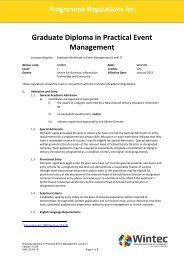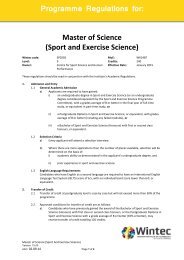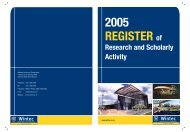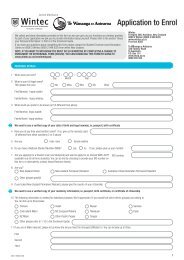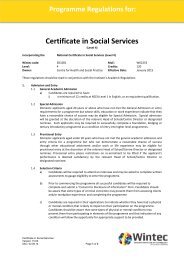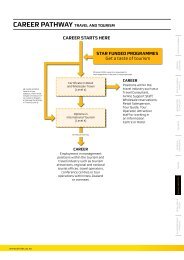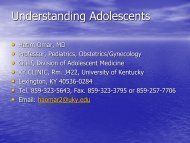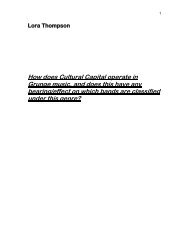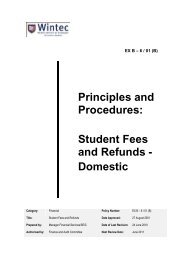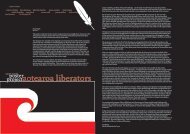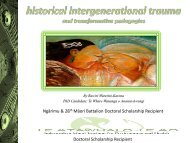2012 wintec annual report
2012 wintec annual report
2012 wintec annual report
You also want an ePaper? Increase the reach of your titles
YUMPU automatically turns print PDFs into web optimized ePapers that Google loves.
NOTES TO THE<br />
FINANCIAL STATEMENTS<br />
For the year ended 31 December <strong>2012</strong>.<br />
A summary of the policies applied to the Institute’s intangible<br />
assets is as follows:<br />
Computer Software<br />
Useful lives<br />
Method used<br />
Internally generated / acquired<br />
Method<br />
Finite 2 - 10 years<br />
Straight line method<br />
Separately acquired<br />
Capitalised intellectual property development costs are still<br />
work in progress. The useful life of completed projects will be<br />
established at project completion.<br />
Goodwill<br />
Goodwill that arises upon the acquisition of subsidiaries is<br />
presented with intangible assets.<br />
Goodwill is initially measured at cost, being the excess of the<br />
aggregate of the consideration transferred over the fair value of<br />
the identifiable net assets acquired and liabilities assumed.<br />
After initial recognition, goodwill is measured at cost less<br />
accumulated impairment losses.<br />
Impairment<br />
The carrying values of plant and equipment other than those<br />
whose future economic benefits are not directly related to their<br />
ability to generate net cash are reviewed for impairment when<br />
events or changes in circumstances indicate that the carrying value<br />
may not be recoverable.<br />
Value in use is depreciated replacement cost for an asset where<br />
the future economic benefits or service potential of the asset are<br />
not primarily dependent on the asset’s ability to generate net cash<br />
inflows and where the Institute and Group would, if deprived of the<br />
asset, replace its remaining future economic benefits or service<br />
potential.<br />
For an asset that does not generate largely independent cash<br />
inflows, the recoverable amount is determined for the cashgenerating<br />
unit to which the asset belongs.<br />
If any such indication exists and where the carrying values exceed<br />
the estimated recoverable amount, the assets or cash-generating<br />
units are written down to their recoverable amount.<br />
The recoverable amount of plant and equipment is the greater<br />
of fair value less costs to sell and value in use. In assessing value<br />
in use, the estimated future cash flows are discounted to their<br />
present value using a discount rate that reflects current market<br />
assessments of the time value of money and the risks specific to<br />
the asset.<br />
If an asset’s carrying amount exceeds its recoverable amount,<br />
the asset is impaired and the carrying amount is written-down to<br />
the recoverable amount. For revalued assets the impairment loss<br />
is recognised in other comprehensive income to the extent the<br />
impairment loss does not exceed the amount in the revaluation<br />
reserve in equity for that same class of asset. Where that results<br />
in a debit balance in the revaluation reserve, the balance is<br />
recognised in the surplus or deficit.<br />
Assets held for educational and related matters and related<br />
activities are assessed for impairment by considering the assets<br />
for obsolescence, changes in useful life assessments, optimisation<br />
and other related matters.<br />
Creditors and other payables<br />
Short term creditors and other short term payables are recorded<br />
at their face value.<br />
Interest-bearing loans and borrowing<br />
All loans and borrowings are initially recognised at cost, being the<br />
fair value of the consideration received net of transaction costs<br />
associated with the borrowing.<br />
After initial recognition, all borrowings are measured at amortised<br />
cost using the effective interest method.<br />
Borrowings are classified as current liabilities unless the Institute<br />
or Group has an unconditional right to defer settlement of the<br />
liability for at least 12 months after the balance date or if the<br />
borrowings are expected to be settled within 12 months of the<br />
balance date.<br />
Employee entitlements<br />
Short-term employee entitlements<br />
Employee benefits that are due to be settled within 12 months<br />
after the end of the period in which the employee renders the<br />
related service are measured at nominal values based on accrued<br />
entitlements at current rates of pay. These include salaries and<br />
wages accrued up to balance date, <strong>annual</strong> leave earned but not<br />
yet taken at balance date, and sick leave. A liability for sick leave



